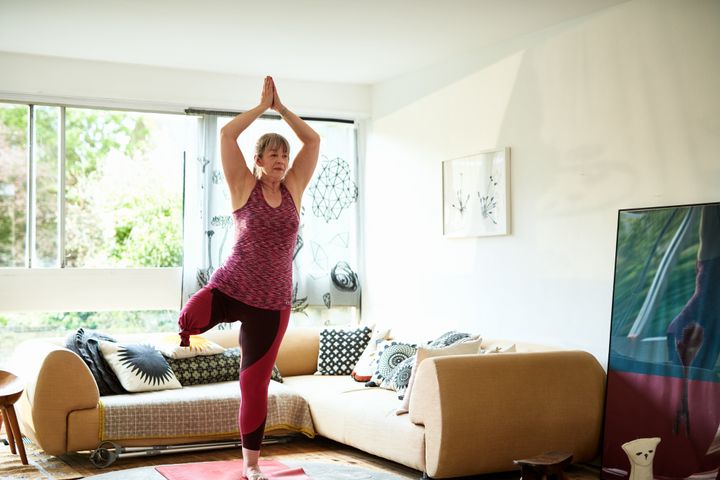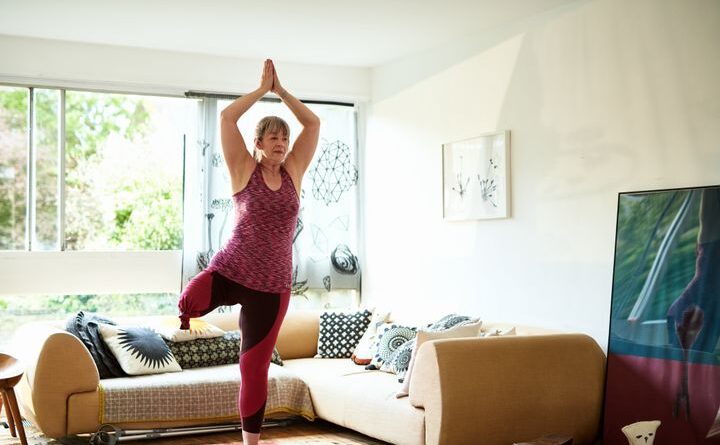This 1 Exercise Test Can Determine Your Risk of Falling
Aging can be difficult for many reasons, not the least of which is an increased risk of falls and injuries. According to the Centers for Disease Control and Prevention, more than 14 million adults fall each year, and falls are the leading cause of fatal and nonfatal injuries in this age group.
It is difficult to know if you are at risk of falling. However, a recent study led by Mayo Clinic researchers found that one fitness test can help determine the risk of falling: the ability to stand on one leg.
The study, published in the Public Library of Science One journal, looked at 40 healthy people over the age of 50 who did not have neuromuscular disorders. Half of the participants were under the age of 65, while the rest were over 65.
The researchers measured knee strength, grip strength, gait while walking on a flat surface, and 30 seconds of one-leg balance. Of all measures, balance decreased most with age; nondominant leg power decreased by 2.2 seconds per decade, while dominant leg power decreased by 1.7 seconds per decade.
The researchers looked at different balance studies and found that testing the balance of the nondominant leg was the best way to measure age-related neuromuscular decline, according to Dr. Jeevan Abraham, a sports medicine physician at Northwestern Medicine in Chicago who was not involved in the study.
This is important because balance is good, reducing the risk of falling.
“Every time you take a step, you’re standing on one foot as you take that step,” said Dr. Gregory W. Stewart, co-founder and co-director of the Sports Center at Tulane University in New York. Orleans, who was also not involved in education. If your balance is low, you may fall, which can lead to injury.
“As you get older, a lot of people lose bone … so a fall can cause a break,” Stewart said, noting that people can hit their head and suffer a concussion or brain bleed.
Balance can also reflect how your brain works in other areas.
“When you start getting into balance issues, you’re taking on a lot of parts of the brain – of course some of it is energy, but you’ve got vision, you’ve got the inner ear system, you’re it has all the connectivity that goes through the nervous system … it’s more than just energy,” Stewart said .”
This study has limitations, however: with only 40 people, it’s a small sample size. In addition, only healthy people were included, which means that these findings may not apply to people with health conditions.
How long should you be able to balance?
So, how long should you balance? The answers are mixed.
In the study, researchers had participants balance for 30 seconds at a time. In a press release, study author Kenton Kaufman said, “If you can stand on one leg for 30 seconds, you’re doing well.”
“I’m sure there will be a lot of people who probably won’t make it to 30 seconds, but I think it’s a good way to see how long the balance will take during that time. ,” said Abraham.
Don’t be discouraged if you can’t balance 30 seconds, Stewart said, adding that most people won’t hit that number, but 15 to 20 seconds is a good goal to aim for. balancing on one leg.
There are ways you can improve your balance.
“My first suggestion is to avoid sitting too long,” Abraham said.
He added: “Personally, from my practice, I tell my patients that I wouldn’t suggest sitting for longer than 30 minutes at a time, because if you wake up a lot, there’s less chance of your muscle wasting.”
So instead of sitting at your computer for hours on end, get up every now and then, even if it’s to get a glass of water or go pet your dog.
Then try to incorporate daily routines like taking the stairs if possible [and a] daily routine because these little things really add up,” said Abraham. “Ignoring those things is what I think leads to some people losing their ability to balance and power.”
In addition, every ten years starting at 30, people lose 8% of their muscle mass, Abraham said. This makes it important to build up your strength as you age, and again, something he explained can be done through resistance training.
You can try to do chair squats, which do not require additional equipment (except for a chair), or challenge yourself on the weight machines at the gym. Bodyweight exercises, such as push-ups, planks and jacking jacks, are another good place to start.
“Participating in resistance training is very important for everyone,” Abraham said.
Yoga and tai chi are also good ways to focus on your balance, Stewart said, recommending that people start as soon as possible and not just when you first notice changes in your balance.
However, before you jump into a new exercise routine, you should talk to your doctor or even a physical therapist to learn ways to improve your balance and overall health through exercise. you are safe.

10,000 Hours via Getty Images
Whatever you do, don’t ignore the fall.
It’s easy to explain a crash or make excuses for why it happens. But Stewart said it’s not something you should do or accept for an elderly relative.
“We all have ‘oops’ and falls once in a while, but if you have more than one… maybe you should go see someone first and make sure you’re not at risk, Stewart said.
He realized that falls can be caused by balance problems as well as strength, inner ear and vision problems. Arthritis can even cause balance problems, Abraham added.
Whatever the cause, it’s important to see your primary care doctor or a physical therapist who can help you determine exactly what’s going on.
We Need Your Support
Support HuffPost
Are you already involved? Log in to hide these messages.
While cardio and strength training may seem like it, balance is also important to consider when it comes to health and healthy aging.
“I think we are taking [balance] no matter how young we are,” Abraham said, and added that maintaining balance is important if you want to have a certain quality of life as you grow older.
If you can’t balance while walking or keep injuring yourself from falling, you won’t be able to achieve many goals that people have, such as walking, playing on the floor and your grandchildren or around. to see friends and family.
“Equilibrium is a symptom of aging and something you can do something about,” Stewart said. “There are things you can do depending on the level of training [and] when you start talking about it, the problems will decrease.”
#Exercise #Test #Determine #Risk #Falling
